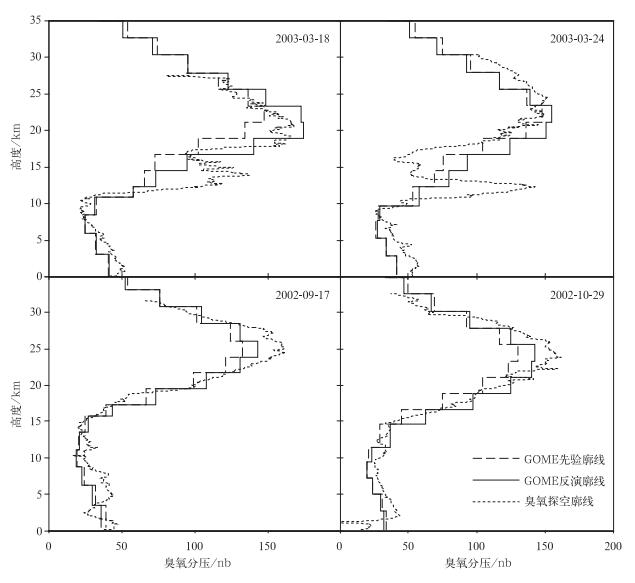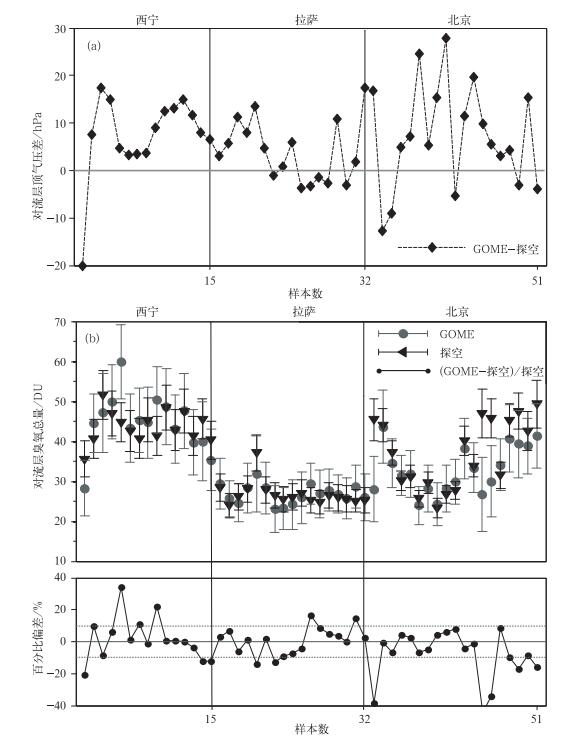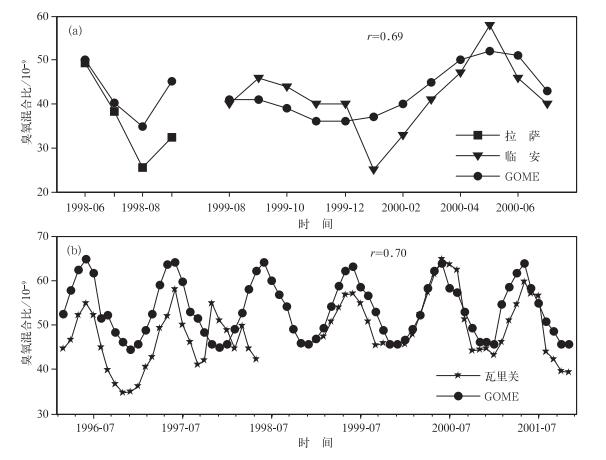利用探空资料验证GOME卫星臭氧数据
Validation of GOME Ozone Profiles and Tropospheric Column Ozone with Ozone Sonde over China
-
摘要: 利用1996年3月-2003年6月部分时段拉萨、西宁、北京3个站的臭氧探空资料验证了GOME(Global Ozone Monitoring Experiment)卫星臭氧廓线及对流层臭氧柱总量。对比结果表明:在对流层中下层,拉萨和西宁两地GOME与探空的平均偏差小于5%,北京地区平均偏差小于10%;在对流层上层/平流层下层,拉萨和西宁平均偏差小于10%,北京小于20%;在平流层中上层3个站的平均偏差均小于5%。在对流层上层/平流层下层区域,GOME与臭氧探空的平均偏差在北京明显高于拉萨和西宁。3个地区对流层柱总量的平均偏差都在10%以内,表明该资料可用于研究我国对流层臭氧总量的变化规律。同时段的GOME最低层(0~2.5km)月平均臭氧浓度对比结果显示,GOME结果同地面臭氧观测值有很好的相关性,GOME臭氧浓度反映了拉萨、瓦里关、临安地面臭氧浓度的主要变化特征。Abstract: Global Ozone Monotoring Experiment (GOME) with the second Earth Remote Sencing (ERS-2) on board launched in 1995. To evaluate the performance of GOME's ozone data in China, ozone sonde observations at three stations in Lhasa (1998--1999), Xining (1996), and Beijing (2002--2003) are used to vali date ozone profiles and tropospheric column ozone retrieved from Global Ozone Monitoring Experiment (GOME). Ozone detecting systems are electrochemical concentration cell (ECC) sonde at Lhasa and Xining and GPSO3 sonde at Beijing; GOME data are retrieved by Liu et al. A comparison dataset consists of 51 matching pairs are obtained by applying a baseline criteria (±6 h, ±3° longitude, ±1.5° latitude). A statistical analysis of the differences between coincident O3 profiles obtained by GOME and those obtained by ozone sondes are conducted using the methodology suggested by von Clarmann. When comparing with measurements the ozone sondes vertical resolution are much better than satellite retrievals. Retrieval averaging kernels are applied to the high-resolution data so that these data are comparable. As the high-resolu tion sondes profiles do not cover the GOME retrieval altitude range, the high-resolution profile (ozone sonde only up to about 30 km) are augmented with monthly mean climatological profiles from TOMS V8. Statistical bias determination and precision validation show that in the lower and middle troposphere, the mean biases are significant within 5% at Lhasa and Xining and within 10% at Beijing. In the upper tropo-sphere and lower stratosphere, the mean biases are within 10% at Lbasa and Xining and within 20% at Beijing. In the middle and upper stratosphere, the mean biases are within 5% at all three locations. The larger bias in the troposphere and lower stratosphere at Beijing may result from a different type of ozone sonde and different time period (ozone profiles shows multiple peaks in Beijing area in the spring). The mean biases of the tropospheric column ozone are within 10 at all three sites, which are partly caused by different estimated tropopause heights between GOME and ozone sondes. The GOME monthly mean ozone concentration at 0—2.5 km correlates well with surface ozone measurements. basically capturing the termporal variations of surface ozone at Lhasa, Waliguan, and Linan. In conclusion, from lower troposphere to upper stratosphere, GOME data used here has strong ability to reflect ozone distribution and dynamic changes in China.
-
Key words:
- validation;
- ozone profile;
- tropospheric column ozone;
- GOME
-
图 1 拉萨(a)、西宁(b)、北京(c)GOME资料与臭氧探空资料对比
(圆点线:各层臭氧总量的相对偏差;黑细线:标准偏差;误差棒:3倍标准误差;阴影区:相对的合成的随机误差;虚线:合成的误差;带箭头数字表示该层样本数)
Fig. 1 Comparison of ozone partial column between GOME and ozone sonde at Lhasa (a), Xining (b) and Beijing (c)
(relative biasis indicated as line with solid circles; standard deviation as thinline; 3σ standard error as errorbars indicating standard error of the mean; combine destimated random error as shaded areas and combined smoothing error and random error as dotted line, respectively)
表 1 臭氧探空站点列表
Table 1 List of ozone sonde stations

表 2 ECC臭氧探空仪误差估计
Table 2 Error estimation of ECC ozone sonde

表 3 GOME卫星数据同臭氧探空对比结果
Table 3 Result of comparison of GOME and ozone sonde

表 4 臭氧积分柱总量的对比结果

-
[1] Chance K V, Burrows J P, Perner D, et al. Satellite measurements of atmospheric ozone profiles, including tropospheric ozone, from ultraviolet/visible measurements in the nadir geometry:A potential method to retrieve tropospheric ozone. J Quant Spectrosc Radiat Transfer, 1997, 57(4):467-476 doi: 10.1016/S0022-4073(96)00157-4 [2] Munro R, Siddans R, Reburn W J, et al. Direct measurement of tropospheric ozone from space. Nature, 1998, 392:168-171 doi: 10.1038/32392 [3] Hoogen R, Rozanov V V, Burrows J P. Ozone profiles from GOME satellite data:Algorithm description and first validation. J Geophys Res, 1999, 104(7):8263-8280 https://www.researchgate.net/publication/37923233_Ozone_profiles_from_GOME_satellite_data_Algorithm_description_and_first_validation [4] Hasekamp O P, Landgraf J. Ozone profile retrieval from backscattered ultraviolet radiances:The inverse problem solved by regularization. J Geophys Res, 2001, 106(8):8077-8088 https://www.researchgate.net/publication/248801906_Ozone_profile_retrieval_from_backscattered_ultraviolet_radiances_The_inverse_problem_solved_by_regularization [5] Van Der A R J, Van Oss R F, Piters A J M, et al. Ozone profile retrieval from recalibrated GOME data. J Geophys Res, 2002, 107(15):4239 doi: 10.1029/2001JD000696/full [6] Muller M D, Kaifel A K, Weber M, et al. Ozone profile retrieval from Global Ozone Monitoring Experiment (GOME) data using a neural network approach (Neural Network Ozone Retrieval System (NNORSY)). J Geophys Res, 2003, 108(16):4497 doi: 10.1029/2002JD002784/full [7] Rodgers C D. Inverse Methods for Atmospheric Sounding:Theory and Practice. World Scientific Publishing Co Ltd, 2000 [8] Liu X, Chance K, Sioris C E, et al. Ozone profile and tropospheric ozone retrievals from the Global Ozone Monitoring Experiment:Algorithm description and validation. J Geophys Res, 2005, 110:D20307 doi: 10.1029/2005JD006240 [9] Liu X, Chance K, Sioris C E, et al. Intercomparison of GOME, ozonesonde, and SAGE Ⅱ measurements of ozone:Demonstration of the need to homogenize available ozonesonde data sets. J Geophys Res, 2006, 111(D14):D14305 doi: 10.1029/2005JD006718/abstract [10] Smit H G J, Julich K D. Ozone Sonde Inter-comparison Experiment-1996 (JOSIE-1996). Global Atmosphere Watch Report Series, WMO/TD-No.926, No.130.Geneva:WMO, 1998:38-44 [11] Herman G J Smit, Wolfgang Straeter. JOSIE-1998 Performance of ECC Ozone Sondes of SPC-6A and ENSCI-Z Type. Global Atmosphere Watch Report Series, WMO/TD-No.1218, Geneva:2004 [12] 宣越健, 马舒庆, 陈洪滨.国产GPSO3与芬兰Vaisala臭氧探空仪的比对试验.高原气象, 2004, 23(3):394-399 http://www.cnki.com.cn/Article/CJFDTOTAL-GYQX200403016.htm [13] 王庚辰, 孔琴心, 宣越健. GPSO3和Vaisala臭氧探空仪平行施放比对结果的初步分析.应用气象学报, 2004, 15(6):672-680 http://qikan.camscma.cn/jams/ch/reader/view_abstract.aspx?file_no=20040682&flag=1 [14] Bian J, Gettelman A, Chen H. Validation of satellite ozone profile retrievals using Beijing ozonesonde data. J Geophys Res, 2007, 112.D06305 doi: 10.1029/2006JD007502/full [15] Cortesi U, Lambert J C, Clercq C D, et al. Geophysical validation of MIPAS-ENVISAT operational ozone data. Atmos Chem Phys, 2007, 7:4807-4867 doi: 10.5194/acp-7-4807-2007 [16] Liu Yi, Cai Zhaonan, Erkki Kyrola. Comparison of ENVISAT GOMOS and MIPAS Ozone Profiles with Balloon Sonde Measurements from Beijing. ESA Special Publication (SP-655), 2008 [17] Wang T, Cheung T F, Li Y S. Emission characteristics of CO, NOx, SO2 and indications of biomass burning observed at a rural site in eastern China. J Geophys Res, 2002, 107(D12):4157, 10.1029/2001JD000724 doi: 10.1029/2001JD000724 [18] 乜虹, 牛生杰, 王治邦, 等.青藏高原清洁地区近地面层臭氧的特征分析.干旱气象, 2004, 22(1):1-7 http://www.cnki.com.cn/Article/CJFDTOTAL-GSQX200401001.htm [19] 汤洁, 周凌晞, 郑向东, 等.拉萨地区夏季地面臭氧的观测和特征分析.气象学报, 2002, 60(2):221-229 http://www.cnki.com.cn/Article/CJFDTOTAL-QXXB200202012.htm [20] Rodgers C D. Characterization and error analysis of profiles retrieved from remote sounding measurements. J Geophys Res, 1990, 95(5):5587-5595 doi: 10.1029/JD095iD05p05587/abstract [21] Rodgers C D, Connor B J. Intercomparison of remote sounding instruments. J Geophys Res, 2003, 108(D3):4116-4229 https://www.researchgate.net/publication/228832294_Intercomparison_of_remote_sounding_instruments [22] Von Clarmann T. Validation of remotely sensed profiles of atmospheric state variables:Strategies and terminology. Atmos Chem Phys, 2006, 6:4311-4320 doi: 10.5194/acp-6-4311-2006 [23] Bevington B R. Data Reduction and Error Analysis for Physical Sciences (3rd Edition). New York:McGraw-Hill Book Company, 2003:51-71 [24] 王庚辰, 孔琴心, 陈洪滨, 等.北京上空大气臭氧垂直分布的特征.地球科学进展, 2004, 19(5):743-748 http://www.cnki.com.cn/Article/CJFDTOTAL-DXJZ200405009.htm [25] 郑向东, 李伟.国产臭氧探空仪观测数据质量分析.应用气象学报, 2005, 16(5):608-618 http://qikan.camscma.cn/jams/ch/reader/view_abstract.aspx?file_no=20050578&flag=1 [26] Ziemke J R, Chandra S, Bhartia P K. "Cloud slicing":A new technique to derive upper tropospheric ozone from satellite measurements. J Geophys Res, 2001, 106(D9):9853-9868 doi: 10.1029/2000JD900768 [27] Zheng Xiangdong, Chan Chuenyu, Cui Hong, et al. Characteristics of vertical ozone distribution in the lower troposphere in the Yangtze River Delta at Lin'an in the spring of 2001. Science in China (Earth Sciences), 2005, 48(9):1519-1528. doi: 10.1360/03yd0492 -


 设为首页
设为首页 加入收藏
加入收藏



 下载:
下载:



